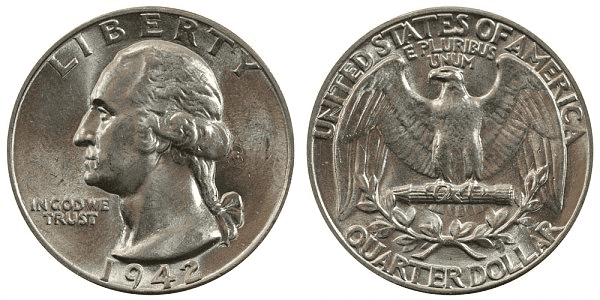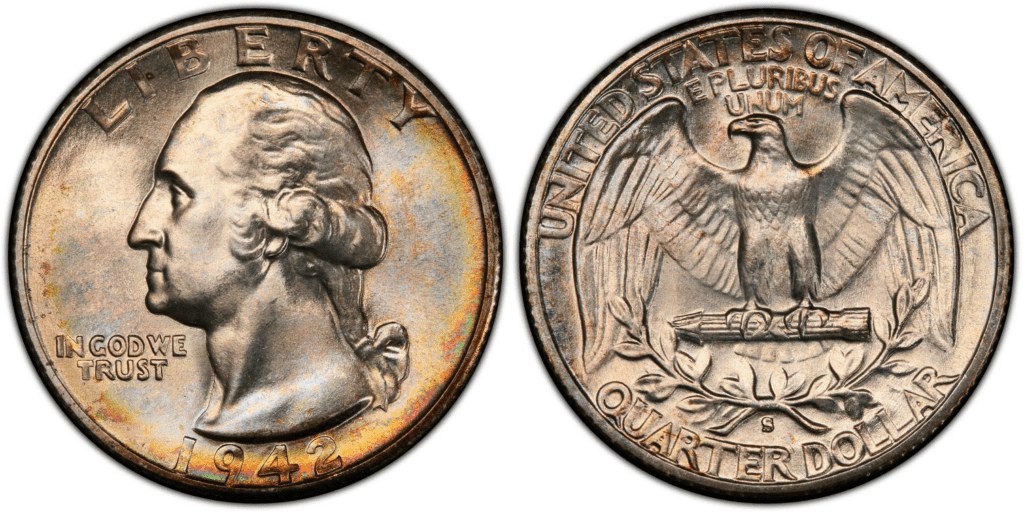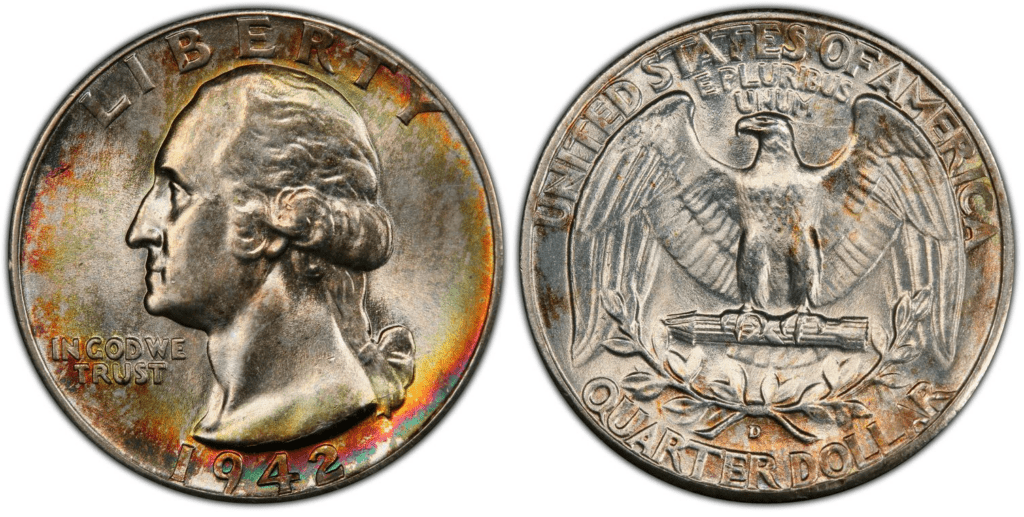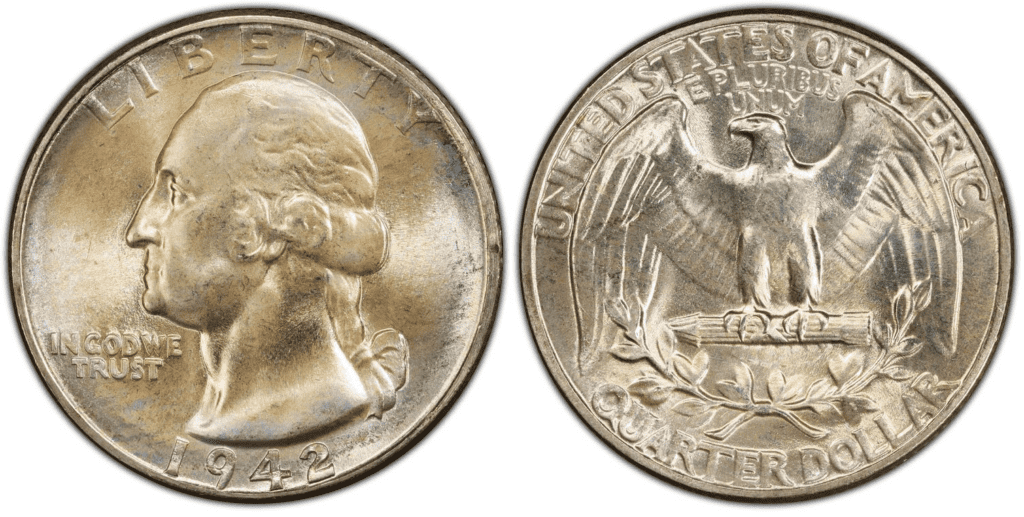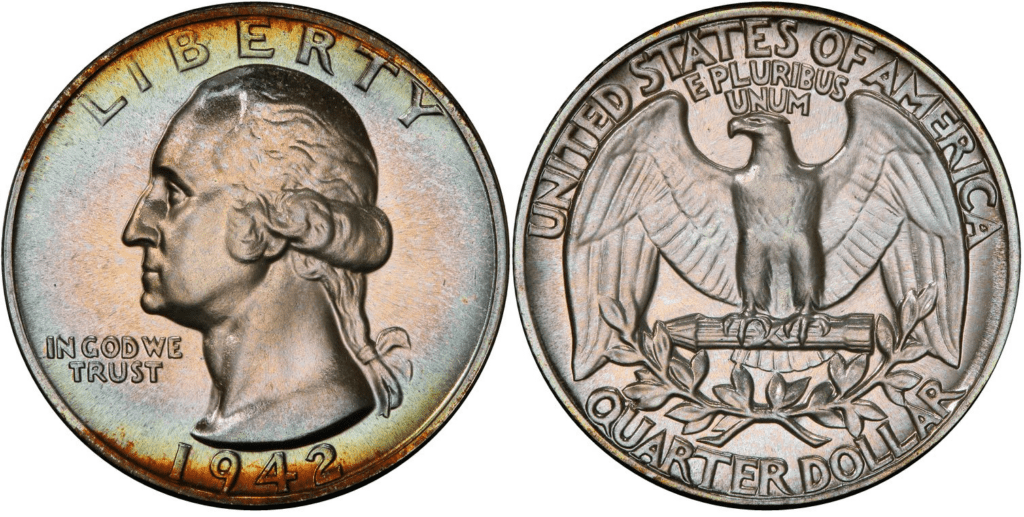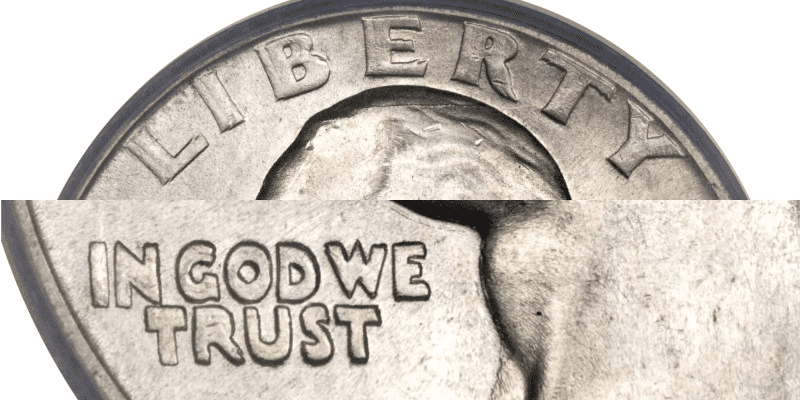What Is the 1942 Washington Quarter Made Of?
This is the first coin in its series to reach a mintage of over 100 million. The 1942 Washington Quarter is sold at a minimal cost despite having 90% silver content. It is regarded as ‘beautiful’ in uncirculated condition.
As mentioned earlier, it is composed of 90% silver and 10% copper for added durability.
Image Source: USA Coin Book 1942 Washington Quarter
Aside from the controversial bust of Washington on the obverse, other engravings include the US motto, “IN GOD WE TRUST,” “LIBERTY,” and the year “1942.”
On the reverse, you will find an image of a bald eagle, considered the nation’s emblem. It is seen on top of an olive branch that symbolizes peace. An inscription on top of the eagle’s head is “E PLURIBUS UNUM,” Latin for “Out of many, one” — a traditional motto for the U.S. Other inscriptions include the following:
- QUARTER DOLLAR
- UNITED STATES OF AMERICA
- Mint mark (if present)
The coin weighs 6.30 grams and has a diameter of 24.3 millimeters.
The obverse side features a left-facing portrait of U.S. President George Washington, done by John Flanagan. But there was some debate regarding choosing Flanagan’s work.
Plans were made to commemorate Washington’s bicentennial birthdate. One was for a new coin, meant to be a half-dollar, that would only be produced for a year.
A portrait of Washington by Laura Gardin Fraser was initially chosen.
The Washington coin, however, was ultimately selected to be a quarter and a long-lasting currency. As a result, Andrew W. Mellon, the Treasury Secretary, was tasked with selecting a design. The committee that oversaw the bicentennial preparations preferred Fraser’s, but Mellon favored the Flanagan portrait.
1942 Washington Quarter Varieties
Through its three primary mint facilities, which are situated in San Francisco, Denver, and Philadelphia, the US Mint created the 1942 Washington quarter. The principal distinctions between the 1942 variations are their mint markings and the location in which they were produced.
The names of the 1942 variants are 1942-S, 1942-D, 1942-P, and 1942-P-proof Washington quarter. During coin production, the mint also made mistakes, leading to the production of some error coins. The quantity of Washington quarters produced varied at each mint facility.
Refer to the table below for the summary of the mintage figure:
| Variety | Location | Mintage |
| 1942-S Washington Quarter | San Francisco | 19,384,000 |
| 1942-D Washington Quarter | Denver | 17,487,200 |
| 1942-P Washington Quarter | Philadelphia | 102,096,000 |
| 1942-P Washington Quarter Proof | Philadelphia | 21,000 |
| Total | 138,988,200 |
To learn more about these 1942 Washington quarter variations, see the descriptions below:
1942-S Washington Quarter
Edge: Reeded
Mint Mark: S
Place of minting: San Francisco
Year of minting: 1942
Face Value: $0.25 (twenty-five cent)
Price: $8 to $25 (circulated condition)
Quantity produced: 19,384,000
Designer: John Flanagan
Composition: 90% silver and 10% copper
Mass: 6.30 grams
Diameter: 24.3 millimeters
Thickness: 1.75 millimeters
Image source: PCGS
The San Francisco Mint increased quarter dollar production in 1942, reflecting development at the other two locations.
An S-marked 1942 quarter has a somewhat better value than those from other sites at lower grades. A coin in exceptionally excellent condition is worth about $9, while one in MS60 is worth roughly $26.
However, MS67 is worth only $260 instead of $575 for Philadelphia or Denver coins. This is so because the San Francisco mint apparently generated more quarters of superior quality.
1942-D Washington Quarter
Edge: Reeded
Mint Mark: D
Place of minting: Denver
Year of minting: 1944
Face Value: $0.25 (twenty-five cent)
Price: $6.18 to $9.54 (circulated condition)
Quantity produced: 19,384,000
Designer: John Flanagan
Composition: 90% silver and 10% copper
Mass: 6.30 grams
Diameter: 24.3 millimeters
Thickness: 1.75 millimeters
Image source: PCGS
Denver generated the fewest of the three facilities that hit 1942 quarters. Even so, the facility could still produce over 17 million, so just because a coin has the Denver mint mark doesn’t automatically make it extraordinary.
The starting price for an MS60 sample in mint condition is $18. Philadelphia quarters are valued at $36 versus $50 for gem-quality coins that are MS65 grade. As mentioned earlier, the value of quarters from both Philadelphia and Denver facilities at MS67 grade is the same, priced at $575.
The Professional Coin Grading Service, or PCGS, has graded five coins at MS68 as the highest quality. Between 2016 and 2021, auction outcomes have varied from below $3,000 to over $9,000. The highest price ever paid for an MS68 1942-D, with exquisite toning, was $9,600 in 2018.
1942-P Washington Quarter
Edge: Reeded
Mint Mark: none
Place of minting: Philadelphia
Year of minting: 1944
Face Value: $0.25 (twenty-five cent)
Price: $6.18 to $7.36 (or more)
Quantity produced: 102,117,123
Designer: John Flanagan
Composition: 90% silver and 10% copper
Mass: 6.30 grams
Diameter: 24.3 millimeters
Thickness: 1.75 millimeters
Image source: PCGS
Your coin was produced in Philadelphia if it doesn’t have a mint mark on it. Given that in 1942, more than 100 million quarters were produced in that facility, the likelihood of that happening is quite substantial. That makes up more than two-thirds of the entire production of 1942.
Considering this, costs for lower grades are comparable to those for quarters from the two other mints. An “extremely fine” (XF45) Philadelphia Washington quarter is valued at about $7.
Coin values can still be low while they are in mint state or haven’t been circulated. For about $16, you can purchase a coin with an MS60 grade, the lowest available. The lowest grade of “gem quality” coin, an MS65, increases that to $36.
Rates then grow significantly after that. The PCGS prices an MS66 grade at $120. And around $200 for the MS67 coins.
1942-P Washington Quarter proof
Edge: Reeded
Mint Mark: none
Place of minting: Philadelphia
Year of minting: 1944
Face Value: $0.25 (twenty-five cent)
Price: $24 to $40 (or more)
Quantity produced: 21,123
Designer: John Flanagan
Composition: 90% silver and 10% copper
Mass: 6.30 grams
Diameter: 24.3 millimeters
Thickness: 1.75 millimeters
Image source: PCGS
Aside from their usual production, Philadelphia manufactured over 21,000 proof quarters in 1942. These were produced using meticulously polished planchets and carefully designed dies.
These were specifically made for collectors. Therefore, the majority were well-cared for and are still accessible.
A proof with a PR60 rating is worth roughly $40. From then, it increases to $100 at PR65 and $275 at PR67. But the value increases if you acquire a special coin. Astoundingly, the PCGS values the single sample with a PR69 grade at $17,000.
List Of 1942 Washington Quarter Errors
Although the US Mint did its best to produce perfect batches of coins, some coins still came out with errors. Error coins are interesting and, sometimes, rare. So, it’s worth looking at them in this post.
While there are different errors in the 1942 quarter series, the most commonly known and sought-after is the 1942-D Doubled Die Obverse (DDO).
Image source: PCGS
Mistakes in the manufacturing of the obverse die lead to doubled die errors. This occurs when a die gently wobbles while being struck. To fully capture the design, it must be struck numerous times. A double imprint is then left behind and placed on the coins.
The value of a coin with this flaw will depend on how well it is preserved. Even with the lowest grades, it will still be worth between $50 and $100.
You’ll be looking at significant money for the highest grades. Two 1942-D doubled die obverse (abbreviated as DDO) quarters that were graded at MS64 by the PCGS are worth $8,000 apiece.
The 1942-D doubled die reverse or DDR has two versions.
The first one, wherein the olive wreath beneath the eagle, is where the doubling is most prominent. This kind is priced between $50 to $125. The best pieces, two MS64-graded coins, are worth $8,000 individually.
The second one is known as FS-801. The doubling can be seen on the olive branch, but it is particularly prominent on the arrows and the eagle’s beak. Prices for this are lower when they are in worse shape and range from $25 to $44.
There’s an MS66+ grade that is priced at $11,500.
How Much Is The 1942 Washington Quarter Worth Today?
The 1942 Washington quarter has a face value of $0.25. The melt value silver melt value is around $4.33. This is computed from the current silver spot price, which can increase or decrease.
The value of a 1942 quarter in exceptionally perfect condition without a mint mark is approximately $7.50. The cost of coins having an MS60 grade in the uncirculated condition is approximately $10. Coins with an MS65 grade that are uncirculated can be purchased for about $30.
To understand the value of this coin, here’s a 1942 Washington quarter chart that you should see:
| Coin | Condition | Grade | Mintage | Value |
| 1942 D Washington Quarter | Good | G-4 to G-6 | 17,487,200 | $6.18 |
| 1942 D Washington Quarter | Fine | F-12 to F-15 | 17,487,200 | $6.18 |
| 1942 D Washington Quarter | Extremely Fine | XF-40 to XF-45 | 17,487,200 | $7.36 |
| 1942 D Washington Quarter | Uncirculated | MS-60 to MS-62 | 17,487,200 | $25 to $35
|
| 1942 D Washington Quarter | Gem Uncirculated | MS-65 to MS-66 | 17,487,200 | $50 to $115 |
| 1942 D Washington Quarter | Superb Gem Uncirculated | MS-67 to MS-68 | 17,487,200 | $500 to $4,000 |
| 1942 P Washington Quarter | Good | G-4 to VF-35 | 102,096,000 | $6.18
|
| 1942 P Washington Quarter | Extremely Fine | XF-40 to XF-45 | 102,096,000 | $6.18 |
| 1942 P Washington Quarter | About Uncirculated | AU-50 to AU-58 | 102,096,000 | $7.36 |
| 1942 P Washington Quarter | Uncirculated | MS-60 to MS-62 | 102,096,000 | $10 to $15 |
| 1942 P Washington Quarter | Gem Uncirculated | MS-65 to MS-66 | 102,096,000 | $30 to $115 |
| 1942 P Washington Quarter | Superb Gem Uncirculated | MS-67 to MS-68 | 102,096,000 | $550 to $8,500 |
| 1942 S Washington Quarter | Good | G-4 to VF-35 | 19,384,000 | $6.18
|
| 1942 S Washington Quarter | Extremely Fine | XF-40 to XF-45 | 19,384,000 | $6.18
|
| 1942 S Washington Quarter | About Uncirculated | AU-50 to AU-58 | 19,384,000 | $24 |
| 1942 S Washington Quarter | Uncirculated | MS-60 to MS-62 | 19,384,000 | $65 to $85 |
| 1942 S Washington Quarter | Gem Uncirculated | MS-65 to MS-66 | 19,384,000 | $120 to $200 |
| 1942 S Washington Quarter | Superb Gem Uncirculated | MS-67 to MS-68 | 19,384,000 | $600 to $7,850 |
| 1942 P Proof Washington Quarter | Choice Uncirculated | PR-64 | 21,123 | $85 |
| 1942 P Proof Washington Quarter | Gem Uncirculated | PR-65 to PR-66 | 21,123 | $110 to $130 |
| 1942 P Proof Washington Quarter | Superb Gem Uncirculated | PR-67 to PR-68 | 21,123 | $400 to $6,000 |
How Does The Grading System Work?
The Sheldon Scale is used by numismatists to provide a numerical value to coins. The Sheldon Scale goes from poor (P-1) to perfect mint state (P-1) (MS-70). Coins were originally evaluated using words to reflect their condition (Good, Fair, Excellent, Etc.). Unfortunately, coin collectors and dealers had different ideas about what each of these terms represent.
Professional numismatists joined together in the 1970s and established CoinGrading standards. These numismatists now assign grades at key places on the seventy-point scale, using the most regularly utilized numeric points in conjunction with the original adjective grade. The following are the most common coin grades:
-
-
- (P-1) Poor – Indistinguishable and probably damaged; if used, must have a date and mintmark; otherwise, rather battered.
- (FR-2) Fair – Nearly smooth, but without the damage that a coin graded Poor often possesses. The coin must have enough detail to be identified.
- (G-4) Fair – Inscriptions have merged into the rims in some areas, and important elements have been mostly erased.
- (VG-8) Very Good- A little weathered, but all of the primary design elements are visible, albeit faintly. There is little if any, central detail left.
- (F-12) Good – The item is very worn, yet the wear is even, and the overall design details stand out clearly. Rims are almost completely isolated from the field.
- (VF-20) Very Fine – Moderately weathered, with some finer features still visible. The motto or all letters of LIBERTY are readable. Both sides of the coin have entire rims that are separated from the field.
- (EF-40) Extremely Fine – Gently used; all gadgets are visible, and the most important ones are bold. The finer details are bold and clear, however, light wear may be seen.
- (AU-50) Uncirculated – Slight evidence of wear on the coin’s design’s high points; may have contact marks; eye appeal should be adequate.
- (AU-58) Uncirculated Choice – Slight traces of wear, no severe contact marks, almost full mint shine, and great eye appeal.
- (MS-60) Mint State Basal – Strictly uncirculated; no indication of wear on the coin’s highest points, but an unsightly coin with reduced luster, visible contact marks, hairlines, and other flaws.
- (MS-63) Mint State Acceptable – Uncirculated, but with contact scratches and nicks, little reduced shine, but otherwise appealing appearance. The strike is weak to average.
- (MS-65) Mint State Choice – Uncirculated with great mint shine, very little contact blemishes, and exceptional eye appeal. The strike is unusually severe.
- (MS-68) Mint State Premium Quality – Uncirculated with superb luster, no obvious contact marks to the naked eye, and exceptional eye appeal. The strike is quick and appealing.
- (MS-69) Almost Perfect Mint State – Uncirculated with perfect brilliance, a sharp and appealing strike, and extremely good eye appeal. A near-perfect coin with minor imperfections in the planchet, strike, and contact markings (seen only under 8x magnification).
- (MS-70) Mint State Perfect – Under 8x magnification, there are no tiny imperfections discernible; the strike is crisp, and the coin is perfectly centered on a beautiful planchet. Rarely seen on a coin, this coin is bright and whole, with original luster and exceptional eye appeal.
-
Where To Buy Or Sell 1942 Washington Quarter?
You can find 1942 Washington quarters on online sites such as Amazon and eBay. You may also choose to sell them there. In addition to these platforms, there are a number of websites with a focus on buying and selling coins. These websites include Coin Appraiser, Grey Sheet, and USA Coin Book, among many others.
Of course, purchasing or selling coins online has its disadvantages. One is that the currency is only visible in images or videos. You can see the buyer in person if you’re selling coins. Furthermore, you should exercise caution online because there are scammers.
If the Internet is not your thing, you can visit antique, pawn, and coin shops. You could also participate in live auctions.
FAQs
Where is the mint mark on a 1942 quarter?
Only applicable to the Denver and San Francisco coins, you can find either “D” or “S” on the reverse, below the center of the olive branch.
Is a 1942 quarter rare?
It depends on the condition that the coin is in. At an auction conducted by Bowers and Merena, a 1942-S Washington quarter was sold for $1,179. It was in gem condition and didn’t show any handling marks. This coin generated a lot of interest because of its tone. Its surface is a light silver gray with crimson and lavender illumination tones at the edges.
How much is a 1942 silver quarter worth today?
It is valued at $6.20 in average condition and can cost up to $41 or more in uncirculated mint condition. Proof coins can be valued at $150.

